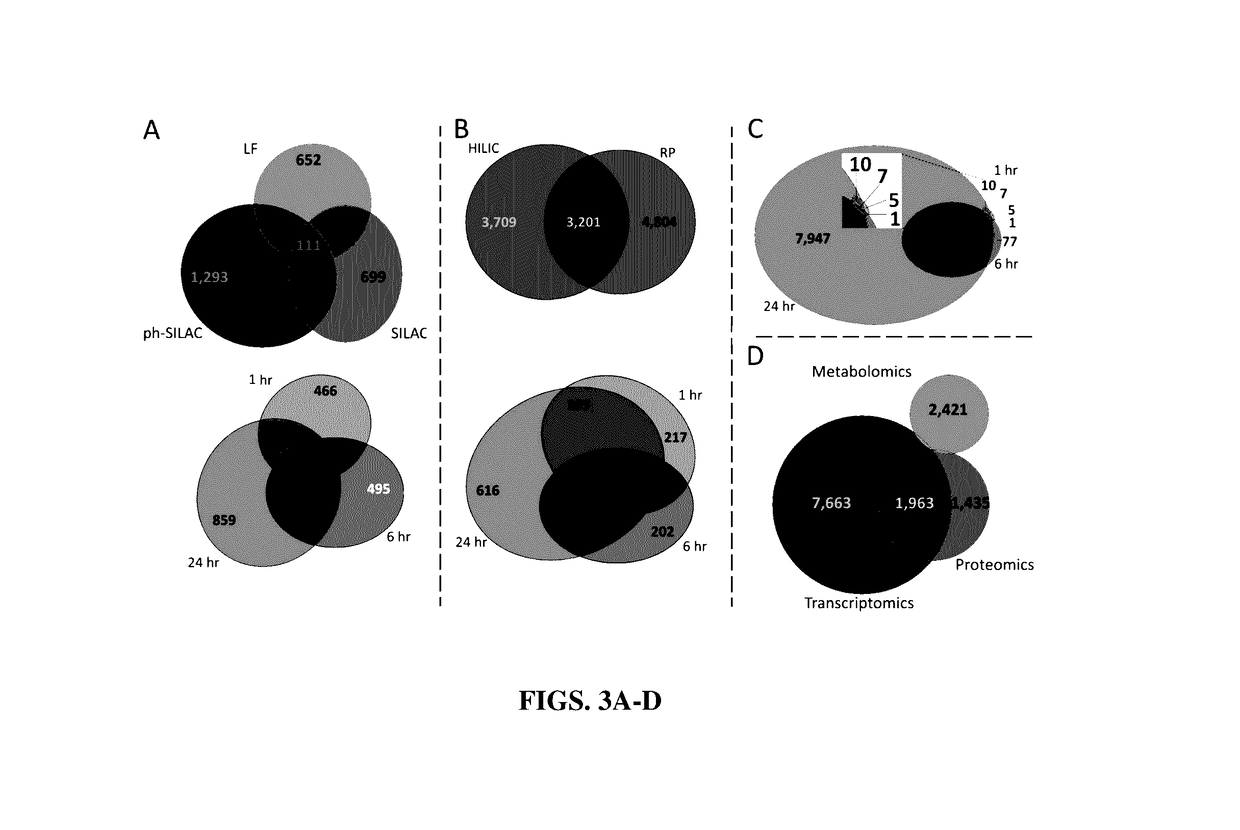High-throughput, multi-omics approach to determine and validate de novo global mechanisms of action for drugs and toxins
a global mechanism of action, high-throughput technology, applied in the fields of molecular and cellular biology, cell physiology, pharmacology, etc., can solve the problems of drug candidate failure in a trial, increased cost, and decline in r&d efficiency for the development of new drugs
- Summary
- Abstract
- Description
- Claims
- Application Information
AI Technical Summary
Benefits of technology
Problems solved by technology
Method used
Image
Examples
example 1
Materials and Methods
[0164]Screening.
[0165]Cell viability and apoptosis were assessed by CellTiter Glo (Promega) and ApoONE (Promega) kits, respectively. Molecular changes were screened using a MALDI-FTICR MS platform.
[0166]Multi-Omics Analysis.
[0167]Samples were analyzed for transcriptome changes by RNA sequencing at the Genomics Services Lab, HudsonAlpha, for proteome changes by label free, SILAC, and phospho-enriched SILAC LC-MS / MS, and metabolome changes by UPLC-IM-MS and data-independent acquisition (MSE) using both hydrophilic-interaction liquid chromatography and reverse phase liquid chromatography.
[0168]Computational Analysis and Data Mining.
[0169]Data from all platforms were integrated and parsed for significantly changed, unique species. The inventors developed an analysis pipeline (manuscript in preparation) implemented in the Python programming language as part of the PySB modeling framework (Lopez et al., 2013). Bioservices (Cokelaer et al., 2013) was used to download p...
example 2
Results and Discussion
[0207]This study validates a multi-omics platform designed to assess the comprehensive MOA of exogenous compounds in 30 days. The inventors considered selection of cell type, exposure methods, and analytical modalities by evaluating stability, reproducibility, utility, and feasibility within 30 days. For this study, they used A549 cells; however, their platform is amenable to various adherent and suspension cell lines. The sponsoring agency selected cisplatin as the test compound and revealed its identity on the first day of the 30-day period.
[0208]FIG. 1 graphically illustrates the three phases of the procedure: 1) molecular screening (days 0-3), 2) discovery analytics (days 4-25), and 3) mechanism construction (days 26-30). Phase 1 screens a wide range of cisplatin dose and exposure times to establish the treatment protocol for discovery experiments. This preliminary screen deduces exposure conditions that provide relevant data for the MOA, allowing the appli...
example 3
Discussion
[0248]The platform described herein utilizes multi-omics technologies for large-scale measurement of molecular events to generate a comprehensive picture of the cellular response to an exogenous compound. Using cisplatin, the inventors demonstrate that this platform can identify primary MOA and pathways important for side effects and resistance. This platform provides several key developments in MOA determination. First, a 3-day screening platform determines relevant exposure and dose, using MS to determine the maximal molecular changes. Second, comprehensive molecular data are collected within 2-3 weeks, including PTMs and metabolomics. These data can generate a tunable output of the final network or mechanism based on statistical confidence in empirical measurements. Last, this platform provides high-throughput, comprehensive MOA assessment. Previous studies successfully identified compound MOA from published datasets of transcriptional changes in response to compounds (...
PUM
 Login to View More
Login to View More Abstract
Description
Claims
Application Information
 Login to View More
Login to View More - R&D
- Intellectual Property
- Life Sciences
- Materials
- Tech Scout
- Unparalleled Data Quality
- Higher Quality Content
- 60% Fewer Hallucinations
Browse by: Latest US Patents, China's latest patents, Technical Efficacy Thesaurus, Application Domain, Technology Topic, Popular Technical Reports.
© 2025 PatSnap. All rights reserved.Legal|Privacy policy|Modern Slavery Act Transparency Statement|Sitemap|About US| Contact US: help@patsnap.com



